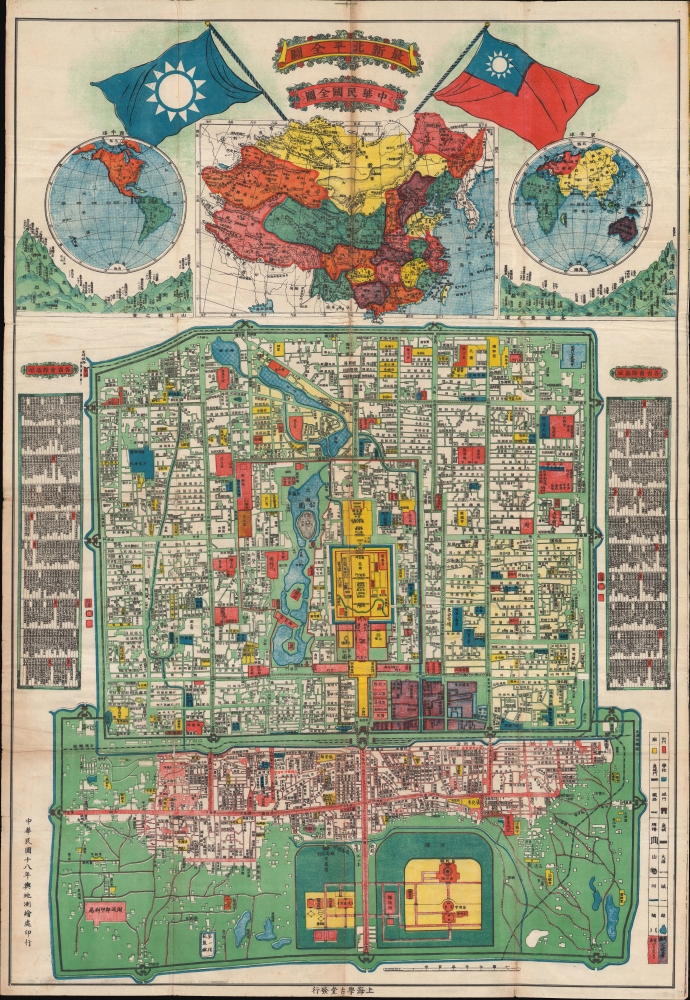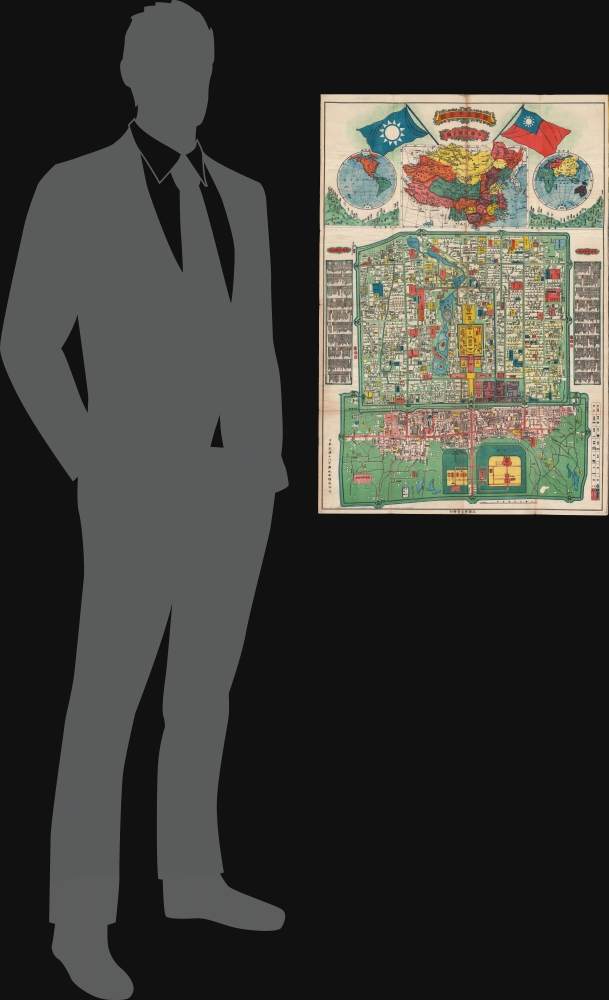This item has been sold, but you can get on the Waitlist to be notified if another example becomes available, or purchase a digital scan.
1929 Republic of China Map Office Propaganda Map of Beijing / Peking
Beijing-roc-1929$1,000.00

Title
最新北京全圖 / Latest Full Map of Beijing. / 中華民國全圖 / Republic of China Map.
1929 (dated) 30.5 x 21 in (77.47 x 53.34 cm) 1 : 17500
1929 (dated) 30.5 x 21 in (77.47 x 53.34 cm) 1 : 17500
Description
A rare 1929 or Minguo 18 chromolithograph propaganda map of Beijing, China, issued by the ROC Mapping Office to commemorate the 18th year of the Beiyang Government / Republic of China.
A Closer Look
The map is large and impressive. At top, it is surmounted by the 'Blue Sky, White Sun, and a Wholly Red Earth' flag of the Republic of China, used from 1911/12 to 1928, and the 'Blue Sky with a White Sun' naval jack. Below the flags, there is a large map of China, flanked on either side by maps of the Western and Eastern Hemispheres, underscoring China's culturally central position as the 'Mandarin Zhongguo' or 'Middle Kingdom.' Below is a detailed map of Beijing, with keys to either side highlighting important sites.Vexillology
The map features the flags of the Republic of China. The right flag is the ROC national ensign, 青天白日滿地紅, literally 'Blue Sky, White Sun, and a Wholly Red Earth', designed by Lu Haodong (陸皓東; 1868 - 1895) and Sun Yat-sen (孫逸仙; 1866 - 1925) in 1895 for the anti-Qing Revive China Society. This flag was used from 1912 to 1928 in mainland China, and until 1945 in Taiwan. The left side is the ROC naval jack (青天白日旗; 'Blue Sky with a White Sun'), designed by Lu Haodong.The Republic of China 1916 - 1928
The Republic of China (ROC) dominated mainland China between 1912 and 1928. It was established in January 1912 when the Qing, China's last imperial dynasty, were overthrown by the Xinhai Revolution. The Republic's first president, Sun Yat-sen, led briefly before handing over the position to Yuan Shikai, the leader of the Beiyang Army. Despite winning general elections, Sun Yat-sen's political party, the Kuomintang (KMT) were increasingly in conflict with Yuan Shikai, who maintained full control of the Beiyang. In 1915, Yuan proclaimed himself the Hongxian Emperor of China, only to abdicate 83 days later due to public outcry. Yuan died shortly thereafter of uremia (or possibly poison), leaving a power vacuum that resulted in the collapse of the Beiyang into multiple sub-armies, bringing forth the Warlord Era. Meanwhile, Sun's party, the Kuomintang, established itself as a rival ROC government in Canton and began the 1926 Northern Expedition, which overthrew the Warlords and briefly reunited China by 1928. The Kuomintang ROC itself was displaced by Mao's Communists and, in 1949, relocated to Taiwan.Chromolithography
Chromolithography is a color lithographic technique developed in the mid-19th century. The process involved using multiple lithographic stones, one for each color, to yield a rich composite effect. Oftentimes, the process would start with a black basecoat upon which subsequent colors were layered. Some chromolithographs used 30 or more separate lithographic stones to achieve the desired product. Chromolithograph color could also be effectively blended for even more dramatic results. The process became extremely popular in the late 19th and early 20th centuries when it emerged as the dominant method of color printing. The vivid color chromolithography produced made it exceptionally effective for advertising and propaganda imagery.Publication History and Census
This map was first issued in 1925. There are several variants - mostly relating to the flags displayed. The 1925 edition bears the 5-color Republic of China flag. This edition, issued in 1929 by 上海学古堂 [Shanghai Xuegutang], is updated the ROC flag and the 'Blue Sky and White Sun' Kuomintang ensign. Rare. Noted in the OCLC, but no holdings cited.Condition
Good. Paper slightly wrinkled due to old Japanese-style repairs on verso. Reversible. Wear on old fold lines.
References
OCLC 55890533.




